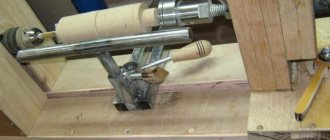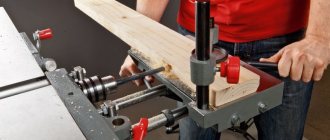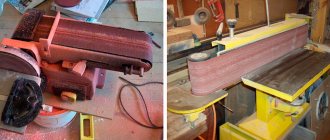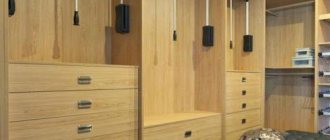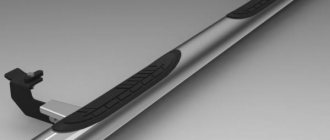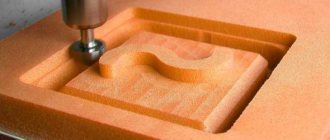Making a lathe
homemade turning and copying machine
The most primitive model of a lathe is made from an ordinary drill. But this is not the only solution. Main parts of the future device:
- bed;
- front and rear pillars (headstocks);
- electric motor;
- master and slave centers;
- tool rest.
The bed is the base for placing all elements and mechanisms. Therefore, it is made of thick timber or metal. The headstock is securely fixed to the base; the part will be attached to it. The front pillar houses a device that transmits movement from the electric motor to the driving center and then to the part.
The rear post (headstock) moves along a guide on the bed; it holds the free end of the workpiece. A tool rest is placed between the headstocks. The headstocks must be positioned strictly along a single axis.
For a do-it-yourself machine, an electric motor with a power of 200 - 250 W, with a speed of no more than 1500, is suitable. If you plan to process large parts, a more powerful motor is required.
A faceplate is placed on the electric motor pulley, which secures large workpieces. The faceplate contains points on which the part is pressed. The opposite end of the part is fixed with a corner.
To turn a regular lathe into a copying machine, an additional device is required - a copier.
Making a machine with your own hands
There are a huge number of copy-type woodworking machines, which are known as pantographs, and have a CNC system (a universal option that allows processing using a copier or program). However, not everyone can purchase such equipment, which is associated with its very high cost. The addition of CNC makes the equipment available only to large manufacturers, when the payback period for the equipment will be less than 5 years. That is why many people ask the question - how to make a machine with your own hands?
Before you start work, it is worth remembering that do-it-yourself machines are significantly inferior to industrial models. At the same time, it is impossible to make a CNC version yourself. Also, many note that converting a regular milling version into a copying version with your own hands is also very difficult, and, often, it is easier to start from scratch. It is not difficult to make a pantograph yourself, but there are still certain difficulties in this process.
Homemade pantograph for a router
There are many schemes by which you can create a copy-milling machine with your own hands. A typical version usually consists of the following elements:
- Desktop;
- supporting frame;
- milling head.
To carry out the procedure for changing the cutting mode, the height of the table changes; the head with the cutter has an electric drive, which sets the cutting tool in motion; often the system includes a transmission mechanism for changing speeds.
The pantograph itself can be made as follows:
- Made of wood. You can create such a pantograph with your own hands, but it will have low processing accuracy, since the wooden parts are connected using a loop. Fastening with loops is characterized by backlash.
- Drawing pantograph made of metal - allows you to create copies at various scales, but cannot be used to create three-dimensional copies.
When creating a machine with your own hands, you should take into account that many parts may have flaws and discrepancies in size. This situation is associated with vibration and trembling of the base, which is quite difficult to avoid. When changing the direction of movement of the cutter, errors are also possible. Due to the internal stress of the wood workpiece, the workpiece may become distorted. Therefore, it is recommended to create such equipment only for narrow-profile production, when the machine will be designed to create one part. It is almost impossible to avoid the problems under consideration, however, provided that the same part is processed, gradual improvement of the design is possible.
Disadvantages of the device in question
Along with numerous advantages, the copier has minor disadvantages. Among them:
- The working surface is guided by hand, because during operation it can jam or warp.
- It is possible to copy simple details.
- To move the tool, it is recommended to choose a helical gear type.
- For universal qualities, it is recommended to replace the cutter with a circular saw.
Thus, to copy complex parts, it is better to install industrial types of equipment. Homemade options are suitable for workshops.
Classic machine design
The machines are equipped with a sophisticated design system. These include CNC models that operate in an automated mode. Such devices are obtained by using drawings and a copying device. The classic design consists of five nodes:
- The main element is a metal frame; individual parts are connected by welding. The bed has different heights, so when creating a homemade machine, this particular parameter is selected.
- The front and tailstock are needed to store the box, drive and electric motor. The rear one fixes the workpiece to obtain dimensional parts.
- An electric motor and drive rotate the workpiece.
- A tool rest is needed for the best quality work. The cut site is protected to prevent injury.
- The master and slave centers secure the part.
Homemade wood turning and copying machine with your own hands
Industrial types of copiers are not cheap, so craftsmen choose the option of constructing a homemade machine. It requires little investment of money and effort.
Performance generally depends on the specifications of the copier. The main task of a self-made device is to create parts according to a template without additional energy consumption.
Required Tools
You won’t need many tools; all of them are publicly available and available to every master:
- Manual frezer.
- The cutter is placed on a support, which can be made of plywood 12 mm thick. Metal is used to improve performance. The dimensions of the platform are about 50x20 cm.
- Bolts.
- Thrust bars.
- A pipe with a diameter of 25 mm will allow you to set the direction of movement of the support platform.
The fundamental cutting tool when constructing a lathe with a copier is considered to be a hand cutter. Even though the copier is made of plywood, it is capable of creating many copies.
Design elements
The simplest and most affordable model of the unit is made from a standard drill. Main equipment spare parts:
- Bed.
- Front, rear grandma.
- Electrical engine.
- Leading, driven center.
- Support for equipment.
All processing components are located on the bed. It can be wooden or metal. The headstock is placed on the platform, and the part is fixed to it. There is a device in front that controls the rotation from the engine to the drive shaft to the part.
The rear post moves along the directional axis; it serves to hold the edge of the profile. Between the headstocks there is a stop for equipment. The products must be on the same plane.
Manufacturing stages
If you need to turn a lathe into a copy machine, you will need an additional device - a copier. Stages of machine assembly:
- You should come up with or download a drawing, which will later be used for assembly. Usually this is a diagram of a standard device that adapts to the copier.
- The process begins with the bed, which requires angles and metal sheets. They are connected by welding. Must meet the requirements of reliability and vibration resistance.
- For maximum functionality of the equipment, an electric motor is installed, designed for 200-250 W, picking up about 1500 rpm. For processing large-sized profiles, it is recommended to choose a higher power motor.
- A faceplate is fixed to the shaft. It is equipped with sharp ends that transmit rotational force.
Particular attention is paid to the manufacture of the copier. It is the main difference between a lathe and a copying machine.
How to make a copier for a lathe?
The copier is indispensable in the production of identical parts. Thanks to it, productivity increases. Some aspects of the copier layout include:
- The main unit is a manual milling cutter that is superfluous in the workshop.
- To install it, a plywood surface is required.
- Holes are made and bars are placed for fastening.
- The bars are fastened with self-tapping screws, which securely fix the devices.
- To cut the workpiece, the platform must move easily along the bed.
- When creating a copier, it is necessary to have a level, because any deviation leads to an error.
- The block is placed horizontally. There is a template for it. The beam is fixed with self-tapping screws.
- The design must be created so that, if desired, the copier can be folded out and the device can be used as standard equipment.
The template is made from plywood and screwed to the front of the beam. The upper platform is checked to ensure it matches the axis on the template.
Installation of structural elements
In order for the copying machine to carry out the most efficient work, and the procedure to be of high quality, rush is eliminated. After studying the drawing, you must adhere to the specified parameters.
It is recommended to pay attention to a few tips:
- The axis for tool movement is set parallel to the axis of the workpiece.
- The coincidence of pipe lines and equipment is an important plus.
- It is important that the bottom edge of the router is aligned with the axis of the equipment. This may vary depending on the installation level of the copier.
- It is better to fix the guide pipe with wooden boards through blind holes.
- The bars of the supporting surface should move and slide easily. If they wobble, the structure will have to be rebuilt.
Some masters are concerned about the moment when high requirements regarding sliding are provided. It’s easy to design a machine with excellent options; just select a straight pipe with smooth walls.
How to make a copier for a wood lathe?
In order to make a copier for a wood lathe, you will need the following components that will be necessary in the manufacturing process:
- electric motor with a power of approximately 800W;
- metal shaft with a nozzle for changing the saw blade;
- metal profile of square section, metal corners;
- wooden sheet;
- furniture guides;
- metal marker;
- fastening materials.
- welding machine, grinder.
First you need to make metal guides.
They will allow you to move the entire copier structure in the longitudinal plane. In this case, two metal corners are used, which are turned over with the sharp side down. The corners are welded together into pieces of metal profile.
This approach allows us to provide the necessary mechanical strength and eliminate the possibility of the guides bending under the weight of the copier. In practice, any other metal profile can be suitable for the manufacture of longitudinal guides, the main thing is that its mechanical parameters allow it to carry out the assigned tasks.
In this case, a wooden box and board were used to make the base of the future copier. The board is sized to allow movement inside the box in a perpendicular plane.
For fastening and subsequent movement, ordinary furniture guides are used.
The engine is attached to the board on top. In this case, the power of the electric motor is 800 W and the speed is 3000 rpm. Depending on your needs, you can use a motor with other parameters.
Next, the shaft should be secured to the board at such a distance that the belt drive normally connects two pulleys, one of which is located at the end of the motor shaft, and the second on the horse shafts of the saw blade. A homemade shaft with one bearing is used here.
A U-shaped structure must be made from a square metal profile. In the upper part of the U-shaped structure, a special metal holder of square cross-section is welded to the horizontal bar. The length of the holder must be less than the length of the marker.
To secure the marker in the holder, holes are drilled on the top plate. A metal nut is welded onto each hole and a bolt is screwed into it. Two bolts will be enough for reliable fixation. The adjustable marker is very convenient when changing saw blades of different diameters.
Simply install the desired disk and use a plumb line to align the marker with the edge of the disk. The marker mount must correspond to the position of the saw blade in all planes. This allows you to simply move the marker along the prepared template to coaxially move the disk along the rotating workpiece.
The entire machine is assembled from two channels and metal corners for the sheath. On which a motor is mounted that rotates a wooden piece. In this case, an electric motor with a power of 1200 W is used.
You can use an old frame from some other machine as a frame. For ease of operation, it is better to place the engine on a removable metal plate, which allows you to move the structure with the workpiece, both in the vertical and horizontal planes.
The clamping head is made of four metal plates in the shape of a rectangular parallelepiped. Two nuts are welded into the end walls of the clamping head, into which a metal screw is screwed. A cone with a cartridge is installed at the end of the screw.
In cases where you need to eliminate the possibility of contamination of the surrounding space with sawdust from the operation of the machine or to minimize the percentage of contamination, you should make a hood.
The saw blade is covered with a metal casing, to which a flexible corrugated hose and a compressor unit are connected to create an air flow of a given power.
Video: making a copier for a wood lathe.
metmastanki.ru
Copier for lathe
guide pipe
The basis of the copier will be an unnecessary manual router. It is placed on a surface made of 12 mm plywood, the size of the platform is 20 x 50 cm. Holes are made in the platform for fasteners and cutters, and stops are installed - bars for fixing the cutter. The router is placed between the clamps and secured with a pair of large nails.
The remote part of the platform moves along the frame along a guide - a pipe. Its ends are fixed in wooden blocks. The bars are attached to the frame with self-tapping screws. When fixing the pipe, you must use a level and align the axis of the pipe with the center of the machine. Before installation, a pair of bars with holes are put on the pipe and can be easily moved along the guide. A platform on which the router is placed is attached to the bars.
stop-copier
The second important element is installed with your own hands directly on the lathe - a block in a horizontal position on which the templates will be attached. A 7 x 3 cm beam is suitable; it is attached to the vertical stands with self-tapping screws. The stands are screwed to the frame. The top surface of the block must clearly coincide with the axis of the machine.
When the copier is not in use, the block is dismantled, the platform with the milling cutter is moved back and the machine turns into a regular lathe.
The stop is made of thick plywood and is attached to the work surface. In fact, the stop plays the role of a copier in this design. It is fixed vertically and fixed to the end of the working surface on a transition beam made of wood. The copier can be removed, it is installed on the stand with self-tapping screws. The stand must be fixed firmly, without the possibility of removal.
The templates are made of plywood and are screwed to the front surface of the block using self-tapping screws. The upper surface of the beam should be aligned with the axis of the template.
Design and principle of operation of the machine
A lathe with a copier has the following device:
- Metal frame. It acts as a base to which the main components of turning equipment are attached. The individual elements are attached to the frame by welding.
- Front and rear pillars (headstocks). They house the drive, electric motor and gearbox. The front pillar is mounted on the platform. It houses a mechanism that ensures the transmission of torque from the power unit to the driving center and the workpiece. The tailstock (thrust) moves along the guide and holds the workpiece. The racks must be located on a single axis.
- Faceplate. It is attached to the electric motor pulley. The faceplate has points on which the workpiece is fixed.
- Spindle chuck. Used to hold the workpiece.
- Master and slave centers. They are used to secure a wooden product.
- Tool rest. It is designed to increase processing accuracy.
This type of turning equipment can also be equipped with additional devices:
- Milling attachment. It allows you to cut channels in a spiral shape in both directions and with different pitches.
- Lunette. It acts as a movable support and is used when working with long parts.
- Sanding attachment. This attachment is used for sanding hardwood products.
The following disadvantages of this design are highlighted:
- The working surface must be periodically moved manually. Otherwise it may jam or tilt.
- Using turning equipment, only simple workpieces can be processed.
- An additional helical gear is required to move the cutting tool.
The lathe has the following operating principle:
- The workpiece being processed is fixed to the spindle chuck.
- The workpiece is pressed by a persistent headstock.
- The electric motor turns on, transmitting torque through the drive to the spindle.
- The spindle transmits motion from the drive to the part.
- Cutters cut off unnecessary elements of the workpiece, giving it the required shape.
The edges of the workpiece inserted into the lathe must be folded. This is necessary so that the cutter fits tightly along the wooden surface.
Copier for lathe
The main element of the copier is a manual router. It is located on a platform made of wood materials with a thickness of 12 mm. Its size is 0.2×0.5 m. The platform contains holes for attaching the cutter and fasteners.
The router should be between the clamps. A separate part of the platform moves along a guide. Its ends are installed on wooden blocks.
Another important element of the copier is a block measuring 7x3 cm. It is fixed in a horizontal position. This element is attached to vertical stands. Templates made of plywood are installed on the block. It is important that the lathe has a thin stop. In this case, it will better copy the template.
If the copier is not used, the block can be dismantled. The platform where the router is located is retracted. To dismantle the copier, you need to unscrew the screws and other fasteners. In this case, the stand where the copier was installed must be tightly fixed.
How to choose the power of wood milling machine equipment for your home workshop
The manual router is designed specifically for work in small workshops or on the road. It is difficult to process large batches of lumber on it; such a machine simply cannot withstand the volume of work. Bulk workpieces are easier to process on stationary machines.
A comment
Andrey Feofanov
Tool selection specialist at VseInstruments.ru
Ask a Question
“To create complex designs on wood, you will have to purchase several types of cutters. Some of them can be made independently, others can be purchased in specialized stores.”
Low-power machines are quite suitable for home and household use. For example, 400 W is enough for small jobs and drilling in soft wood. Machines of this power can be used for cutting grooves. The price of manual wood routers is low, however, the range of functions is very limited.
If you plan to expand the specifics of processing, then it is better to opt for a model with a power of at least 1 kW
With such equipment you can easily work on any type of wood. This is quite enough for household needs. For professional use, it is recommended to choose a machine with a power of at least 1.5 kW. It is not always possible to buy such a wood milling machine, because the price can reach several tens of thousands of rubles. With such a machine it will be possible to process large volumes of wood, as well as plastics, soft alloys, such as aluminum; it will “eat” any type of cutter. Remember that the time it takes to complete a task depends on the power.
Spindle rotation speed is a very important characteristic that affects the price of a wood milling machine; you should pay attention to this parameter when choosing equipment. Processing dry or wet wood of varying densities is most effective at certain speeds
The dimensions of the working platform and the distance from the spindle axis to the worktop determine the dimensions of the workpieces being processed. The accuracy and depth of processing of the part, as well as the ability to select the desired cutter, depend on choosing the right spindle for a wood milling machine.
Dust extraction - when processing wood, an exhaust volute is an irreplaceable thing. Sometimes, for such purposes, ordinary vacuum cleaners are used, which are attached at a certain angle to the frame.
Dimensions and weight of the machine - for an amateur, a compact desktop model is suitable, which is installed on a workbench, and after use it is put away in the pantry. If you have a workshop, it is more advisable to assemble a full-fledged wood milling machine on a bed with your own hands. If you plan to work on a construction site, choose a manual router.
A comment
Andrey Feofanov
Tool selection specialist at VseInstruments.ru
Ask a Question
“The manual electric top-type milling cutter can be stationary or submersible. Fixed models are cheaper, however, less functional. In such a tool, the cutter cannot move relative to the device body.”
Much more convenient to use is a plunge router, the drive motor of which is mounted on special guides and can move along them along with the working attachment during processing. The design of plunge-type milling machines also has a special spring, which ensures the lifting of the working attachment after processing has been completed with its help.
If, in the process of purchasing top-type milling cutters, you choose which one is better, then you should definitely pay attention to submersible models, which are perfect for both professionals and beginners
Capabilities of copy-milling equipment
The copying machine, which belongs to the milling group, is designed for copying and milling work with flat and three-dimensional parts. In addition, such a device can be used to engrave shaped profiles, apply inscriptions and patterns (even of high complexity) to products, and carry out light milling operations on wood and other materials.
An example of the result of a copy-milling machine
Using tools with cutting parts made of various materials, parts made of cast iron, different types of steel and non-ferrous metals are processed on copy milling machines. Such devices for producing parts in small and large batches successfully produce blades for turbojet engines and steam turbines, propellers for ships, cutting and forging dies, impellers for hydraulic turbines, molds for pressing and casting, molds, etc.
A copy-milling machine performs technological operations that are practically inaccessible to universal equipment. The operating principle of such a machine is based on the copying method, for which a special template is used. The use of a template eliminates the human factor when processing even the most complex parts, due to which all finished products have the same shape and geometric dimensions. Conveniently, one template can be used to accurately manufacture a large batch of parts that will be completely identical to each other.
In order to copy the shape and dimensions of the template as accurately as possible, a copier (pantograph for a router) is installed on a copy-milling machine. The purpose of such a device is to accurately transfer all movements from the copy head to the cutting tool.
Examples of manufacturers
Those who need a reliable machine for flat milling should pay attention to the products of the Italian company GRIGGIO. Machines of this brand have a relatively low price and are a good solution for creating shaped parts, skirting boards, and trims
With their help it is convenient to create facades of furniture panels and wooden doors.
The VFK-810 milling machine with a table rotation angle of 45 degrees is perfect for those who are interested in making furniture. Its distinctive feature is the high speed of rotation of the cutter (up to 20,000 rpm), which guarantees excellent surface quality of the finished product.
The Chinese MX 5068 unit has comparable characteristics at a much lower price. It boasts a cutter rotation speed of up to 18,000 rpm and uses a pneumatic drive for table rotation and tool movement.
Those who are planning to take up carpentry seriously should pay attention to a milling unit made in Taiwan. WINNER LH-1000 will be the best assistant when it is necessary to mass produce similar parts
A special feature of the machine is a multi-level spindle, which allows you to perform several operations at once in one pass and create a product of the required profile without the need to rearrange the cutting tool.
Types of copy-milling machines
The equipment of a copy-milling machine may include various types of drives. Based on this parameter, the following are distinguished:
- equipment with a pantograph (suitable for processing parts in 2–3 dimensions);
- devices with a copier mounted on a rotary rack moving in a vertical plane;
- single- and multi-spindle machines equipped with round or rectangular rotary tables;
- machines, the feed on which is ensured by mechanical, electrical, hydraulic devices;
- photocopying equipment.
A homemade copying machine can be any of these types (including copying and grinding machines). You just need to find drawings on the Internet and select components.
An example of a homemade copy-milling machine
According to the degree of automation and the method of fixing the workpiece, the following categories of copy-milling machines are distinguished:
- manual or desktop, on which the workpiece is fixed mechanically (on these devices you can drill holes of various shapes in accordance with the template);
- automatic equipment of a stationary type, the workpieces on which are fixed using pneumatic clamps (such machines work with aluminum);
- automatic equipment of a stationary type with pneumatic clamps, on which a three-spindle head is installed (on these copy-milling machines, triple holes are simultaneously drilled, which does not allow the production of units of the two previous types).
Making a copy-milling machine: step-by-step instructions
After everything is ready, the actual assembly of the copy-milling machine begins.
Step #1
It is necessary to cut two pieces 950 mm long from a 30×60 profile pipe to attach the rail guides. A margin of 50 mm is needed for installing limit switches in order to prevent linear bearings from slipping off.
Step #2
The 40×40 profile pipe needs to be cut into blanks for the base. Guided by the existing sketch, you need to cut two pieces of 1350 mm and two pieces of 900 mm.
Step #3
It is necessary to cut small racks from the same pipe. Their linear size depends on the height of the subsequently processed parts.
Step #4
Now you need to remove the rust from the pipes
To do this, you can use a flap disc or a brush. Important! Before using the brush, pay attention to the maximum number of working revolutions on it and the grinder. The rotation speed on the brush must exceed the speed of the equipment
Step #6
Then it is necessary to ensure parallelism of the rail guides. To do this, you need to make the connection between the rack and the base of the rail guide detachable. It is necessary to take a washer according to the internal size of the rack, weld a nut to it and screw in the bolt. At this stage, the bolt is needed in order to install the nut and washer in the cavity of the stand pipe flush and in a strictly vertical position, and when welding it, do not damage the thread. This must be done with all four racks.
Step #8
At the base of the rail guide, at the junction with the racks, you need to drill holes: in the upper shelf for the bolt head, in the lower one for the thread.
Step #9
Install the rail guides on the base (30×60 pipe), pre-drilling holes, and secure with metal screws.
Step #11
Check the parallelism of the guides. If it is missing, it is necessary to make adjustments by placing foil of different thicknesses on the racks under the guide.
Step #12
On the metal plate you need to mark and drill holes for attaching split linear bearings and end posts.
Step #13
After this, you need to make a movable element by welding 300 mm long rocker arms for the feeler gauge and router to a metal plate, then attach linear bearings to it.
Step #15
The entire structure must be installed on a metal plate 100 mm wide and the end posts must be secured with self-tapping screws.
Step #17
After this, the suspended structure is put on the rail guides with split bearings and the end switches are installed.
Step #19
In order for the workpiece and the part to rotate synchronously, it is necessary to connect them with couplings. A sprocket and crown are suitable for control. The copy milling machine is ready. The design achieved 5 degrees of freedom. Movement along the X axis is ensured by the movement of the structure along rail guides, movement along the Y axis is ensured by the movement of a moving element along a polished shaft, and movement along the Z axis is ensured by the movement of rocker arms.
Additionally, due to the movable couplings, the probe and the milling cutter can move left and right along the axis of the rocker arm, and it is possible to move the template and the workpiece simultaneously. This makes it possible to process parts of almost any shape.
Safety precautions when working with a turning and copying machine
Following the advice of experts when working with a copying lathe will make it possible to avoid numerous unpleasant situations and damage:
- Always check the fastening of elements and protective parts.
- It is necessary to remove unnecessary objects from the machine.
- Tools must be in their place.
- The cutting tool is checked for correct sharpness and proper design.
- The feeding of the equipment is carried out smoothly and without pressure, only after reaching the full rotation speed.
If any malfunctions occur, it is recommended to contact a specialist or carefully inspect all components.
Wood is the most practical and natural material from which you can make household items, furniture and even children's toys. In addition, many residential and non-residential buildings are built from wood. Therefore, many “homemade craftsmen” are not averse to having woodworking machines for their home workshop. They can be purchased at a specialized store or made independently from scrap materials. Let's talk in more detail about the second method of arranging your own corner for work.
Classification of lathes
Many people decide to buy and install lathes in their own workshop because of their possible use in the manufacture of cylindrical products. There are quite a large number of different models; they can be divided into several groups:
- Classic equipment, when the workpiece is located in a chuck or faceplate. A cutter is used as a cutting tool. The workpiece can rotate at different speeds. However, the equipment is not suitable for mass production.
- Copying machines can be used to work from a template. By using a template, you can simplify the task of manufacturing similar products. For small-scale production, a manually operated machine is suitable, as it is low cost and easy to use.
- Milling machines are extremely common today. This is due to the fact that they are widely used in the production of cabinet and flat parts made of wood and metal. There is also a wood turning and milling machine, which can be used to perform various operations.
- Models with numerical control. In mass production or the manufacture of expensive products, equipment that has a CNC unit can be used. However, the use of a copier significantly reduces the cost of the product.
The copying device for a wood lathe has very attractive characteristics, due to which they began to be installed in private and other workshops.


